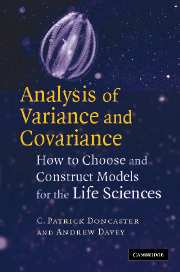Book contents
- Frontmatter
- Contents
- Preface
- Introduction to analysis of variance
- Introduction to model structures
- 1 One-factor designs
- 2 Nested designs
- 3 Fully replicated factorial designs
- 4 Randomised-block designs
- 5 Split-plot designs
- 6 Repeated-measures designs
- 7 Unreplicated designs
- Further Topics
- Choosing experimental designs
- How to request models in a statistics package
- Best practice in presentation of the design
- Troubleshooting problems during analysis
- Glossary
- References
- Index of all ANOVA models with up to three factors
- Index
- Categories of model
Preface
Published online by Cambridge University Press: 13 November 2009
- Frontmatter
- Contents
- Preface
- Introduction to analysis of variance
- Introduction to model structures
- 1 One-factor designs
- 2 Nested designs
- 3 Fully replicated factorial designs
- 4 Randomised-block designs
- 5 Split-plot designs
- 6 Repeated-measures designs
- 7 Unreplicated designs
- Further Topics
- Choosing experimental designs
- How to request models in a statistics package
- Best practice in presentation of the design
- Troubleshooting problems during analysis
- Glossary
- References
- Index of all ANOVA models with up to three factors
- Index
- Categories of model
Summary
Hypothesis testing in the life sciences often involves comparing samples of observations, and analysis of variance is a core technique for analysing such information. Parametric analysis of variance, abbreviated as ‘ANOVA’, encompasses a generic methodology for identifying sources of variation in continuous data, from the simplest test of trend in a single sample, or difference between two samples, to complex tests of multiple interacting effects. Whilst simple one-factor models may suffice for closely controlled experiments, the inherent complexities of the natural world mean that rigorous tests of causality often require more sophisticated multi-factor models. In many cases, the same hypothesis can be tested using several different experimental designs, and alternative designs must be evaluated to select a robust and efficient model. Textbooks on statistics are available to explain the principles of ANOVA and statistics packages will compute the analyses. The purpose of this book is to bridge between the texts and the packages by presenting a comprehensive selection of ANOVA models, emphasising the strengths and weaknesses of each and allowing readers to compare between alternatives.
Our motivation for writing the book comes from a desire for a more systematic comparison than is available in textbooks, and a more considered framework for constructing tests than is possible with generic software. The obvious utility of computer packages for automating otherwise cumbersome analyses has a downside in their uncritical production of results. Packages adopt default options until instructed otherwise, which will not suit all types of data.
- Type
- Chapter
- Information
- Analysis of Variance and CovarianceHow to Choose and Construct Models for the Life Sciences, pp. ix - xivPublisher: Cambridge University PressPrint publication year: 2007



